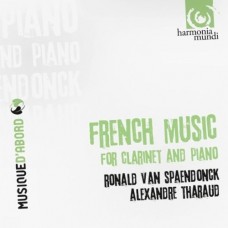您的購物車沒有添加專輯!
搜尋
芳斯瓦-費德里克.基 / 貝多芬:第29、30號鋼琴奏鳴曲 (芳斯瓦-費德里克.基, 鋼琴) Francois-Frederic Guy / Beethoven:Piano Sonatas
專輯編號: HMA1951596
專輯類型: 單CD
發行年份: 2011
國際條碼: 0794881983827
音樂家:
Tharaud, Alexandre (piano) 亞歷山大.薩洛 (鋼琴)
Ronald Van Spaendonck, clarinet 羅納德.范.史本丹克, 豎笛
庫存狀態: 有庫存
舊版編號:HMN911596
HMN系列是HM公司專為音樂圈的新銳俊材所量身打造,諸如小提琴家伊莎蓓兒.佛斯特、奎拉斯以及本片的豎笛史本丹克,甚至是台灣樂迷相當熟悉的薩洛,皆從這個系列開始自己的唱片生涯。這張重發專輯即是出自該系列,比利時豎笛演奏家史本丹克(1970年生)以首獎畢業於布魯塞爾皇家音樂院,後師事波易肯斯和卡爾.萊斯特。曾獲得布魯塞爾等地的國際大賽首獎,更曾與基頓.克萊曼等名家同台演出。2000年九月獲選英國BBC新一代藝術家,2002年更登上英國逍遙音樂節舞台。這份錄音精心收錄諸多法國作曲家的豎笛作品,像是浦朗克與聖桑的奏鳴曲、德布西的第一號狂想曲,也有難得聽聞如改編自德布西的小組曲、米堯著名的「丑角」、高伯特的豎笛幻想曲、奧乃格的小奏鳴曲和法朗賽的主題與變奏。曾多次來台演出,法國新世代鋼琴家亞歷山大.薩洛,巴黎音樂院第一名畢業之後,陸續贏得慕尼黑和巴塞隆納鋼琴大賽金牌,1997年11月曾為法國國立圖書館擔綱演出開幕音樂會,所錄專輯多次獲得法國唱片大獎肯定。上揚唱片曾在2008年11月8日與11日邀請薩洛來台,分別在台北與台中主辦「來自法國的鋼琴王子—亞歷山大.薩洛鋼琴之夜」音樂會。這張錄音中薩洛還是20多歲的青年,樂迷可以從中一窺這位鋼琴家早期與現在的風格差異。
|
Beethoven's Piano Sonatas no.29 and no.30, published in 1819 and 1821 by Artaria and Schlesinger respectively as Opus 106 and Opus 109, are among the fundamental works he wrote for the piano. Moreover, Opus 106 is one of the few sonatas composed specifically 'fur das Hammerklavier' and not 'pour le piano-forte', Artaria having undertaken to publish two versions of it, one in German, the other in French. It is the German term that asserted itself, and the Grose Sonate has ever since been known as the Hammerklavier Sonata. And large this sonata was from every point of view: its scale is gigantic, and its structure is both original and vast. It is one of Beethoven's first works to abandon the traditional harmonia procedure of descending in fourths or fifths in favour of progressions in descending thirds. These progressions, typical of his 'last period', endowed the whole with a new harmonic colour that Schubert was not slow in appropriating. The splendours of this 29th Sonata manifest themselves within the first few bars and go on to unfold themselves in the longest and most sublime Adagio Beethoven ever composed for the piano. The final fugue, of an unprecedented contrapuntal richness, was hardly understood in its time and continues, in the words of the composer, 'to give pianists a hard time . . .'. Written for the most part at Modling in the summer of 1818, the Sonata op.106 was dedicated to Archduke Rudolph. The first movement contains thematic material Beethoven had originally conceived for a 4-part chorus, Vivat Rodolphus, intended for the name-day of the Archduke of Austria. The Sonata op.109 shares its origins with another, and far more ambitious, choral work, the Missa Solemnis, the great undertaking on which he was working from 1819 to 1821. Sketches for both works (as well as for the last piano sonatas, op.110 and 111) are inextricably mixed up in Beethoven's sketchbooks. According to Schindler, the genesis of the last three sonatas was due to an article in Die Allgemeine Musikalische Zeitung, in which it was intimated that Beethoven, drowned in the composition of the Missa Solemnis, was finished. Even if the article might have deeply offended its 'victim', there can hardly be any doubt that Beethoven had other irons in the fire and that the origins of these three new compositions were due to quite different considerations. In this respect Opus 109 in teeming with absolutely thrilling conceptual novelties, beginning with the astonishing first theme, which seems to prefigure a romantic prelude from the harmonic world of a Schumann song. And indeed, the Sonata ends with a dazzling set of variations on a sublimely simple theme, Gesangvoll mit innigster Empfindung, mezza voce (Song-like and with the most ardent feeling). Probably composed in the summer of 1820, the thirtieth Sonata was dedicated to Maximiliana Brentano. |
編號 |
曲目 |
長度 |
作詞 |
作曲 |
演奏 |
樂團 |
演唱 |
指揮 |
試聽 |
|---|


